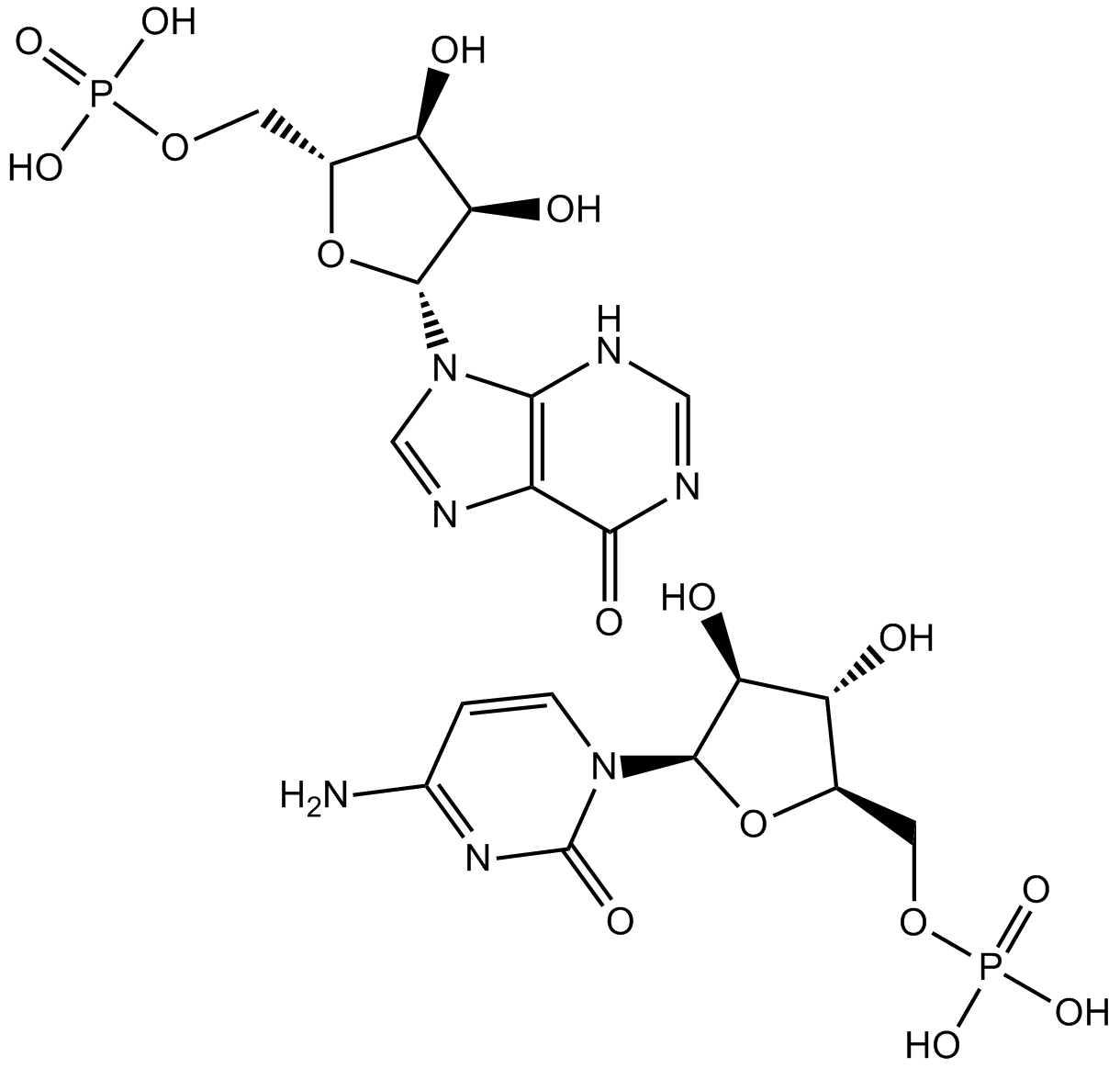Poly(I:C) (Synonyms: Polyinosinic-polycytidylic acid) |
| Catalog No.GC14710 |
Poly(I:C)(Poly(I:C))는 TLR3(Toll-like receptor 3) 작용제인 합성 이중 가닥 RNA(dsRNA)입니다.
Products are for research use only. Not for human use. We do not sell to patients.

Cas No.: 24939-03-5
Sample solution is provided at 25 µL, 10mM.
Poly (I:C), a synthetic double-stranded RNA (dsRNA) analog, is an immunostimulant that acts as the most potent interferon (IFN) inducer. Toll-like receptor- 3 (TLR3) agonist[1].
Poly (I:C) suppressed cytopathic effects (CPE) induced by CHIKV infection in BEAS-2B cells in the presence of Poly (I:C) and inhibited the replication of CHIKV in the cells. Both Poly (I:C) and CHIKV infection upregulate the expression of TLR3 in BEAS-2B cells[1].DsRNA poly(I:C) up-regulated the expression of IFNβ and apoptosis-associated genes in cervical cancer cells, activating both intrinsic and extrinsic apoptotic pathways, and eventually inducing cell death[8].Stable maturation of DC can be simply induced by the addition of polyriboinosinic polyribocytidylic acid (poly(I:C))[3].Poly(I:C) decreased the rate of successful in vitro fertilization via DNA damage and abnormal spindle morphology at the first cleavage and inhibited early embryonic development by inducing immune response and promoting blastocyst cell apoptosis[9]. Mixtures that included the TLR7/8 agonists R848 or CL075, combined with the Poly (I:C), yield 3-d mature dendritic cells [2].
Poly(I:C)-activated macrophages displayed enhanced phagocytosis after CD47 blockade. Compared with mice receiving monotherapy, those received Poly(I:C) in combination with anti-CD47 mAb exhibited significantly inhibited tumor growth[4]. In vivo, poly(I:C) enhanced cell surface expression of Mac-1 on neutrophils in mice and facilitated their infiltration to lung tissues. Poly(I:C) also downregulated thrombomodulin expression in mouse tissues and reduced its circulating soluble level in plasma[5].1.25 and 5 mg/kg poly(I:C) preconditioning significantly reduced myocardial infarct size and cardiac dysfunction. Moreover, poly(I:C) significantly promoted cell survival by restoring autophagy flux and then regulating it to an adequate level Increased autophagy protein Beclin1 and LC3II together with p62 degradation after additional chloroquine[6].In mice,following Poly I:C exposure, a significant decrease in DA-D2 receptor binding, reduction in corpus callosum calibre and MOG immunolabelling indicating demyelination and a significant decrease in locomotor activity, neuromuscular strength and motor coordination signify motor deficits and hypokinetic influence of early life viral infection[7].
References:
[1]: Li YG, Siripanyaphinyo U, et,al. Poly (I:C), an agonist of toll-like receptor-3, inhibits replication of the Chikungunya virus in BEAS-2B cells. Virol J. 2012 Jun 14;9:114. doi: 10.1186/1743-422X-9-114. PMID: 22698190; PMCID: PMC3490739.
[2]: Spranger S, Javorovic M, et,al. Generation of Th1-polarizing dendritic cells using the TLR7/8 agonist CL075. J Immunol. 2010 Jul 1;185(1):738-47. doi: 10.4049/jimmunol.1000060. Epub 2010 May 28. PMID: 20511554.
[3]: Verdijk RM, Mutis T, et,al. Polyriboinosinic polyribocytidylic acid (poly(I:C)) induces stable maturation of functionally active human dendritic cells. J Immunol. 1999 Jul 1;163(1):57-61. PMID: 10384099.
[4]: Zhong C, Wang L, et,al. Poly(I:C) enhances the efficacy of phagocytosis checkpoint blockade immunotherapy by inducing IL-6 production. J Leukoc Biol. 2021 Dec;110(6):1197-1208. doi: 10.1002/JLB.5MA0421-013R. Epub 2021 May 14. PMID: 33988261.
[5]: Cai X, Panicker SR, et,al.Protective Role of Activated Protein C against Viral Mimetic Poly(I:C)-Induced Inflammation. Thromb Haemost. 2021 Nov;121(11):1448-1463. doi: 10.1055/s-0041-1726093. Epub 2021 Mar 11. PMID: 33706396; PMCID: PMC8433266.
[6]: Chen E, Chang H, et,al. Poly(I:C) attenuates myocardial ischemia/reperfusion injury by restoring autophagic function. FASEB J. 2022 May;36(5):e22317. doi: 10.1096/fj.202101220RR. PMID: 35438806.
[7]:Singh B, Dhuriya YK, et,al. Early life exposure to poly I:C impairs striatal DA-D2 receptor binding, myelination and associated behavioural abilities in rats. J Chem Neuroanat. 2021 Dec;118:102035. doi: 10.1016/j.jchemneu.2021.102035. Epub 2021 Sep 28. PMID: 34597812.
[8]: Meng X, Cui X, et,al. poly(I:C) synergizes with proteasome inhibitors to induce apoptosis in cervical cancer cells. Transl Oncol. 2022 Apr;18:101362. doi: 10.1016/j.tranon.2022.101362. Epub 2022 Feb 9. PMID: 35151092; PMCID: PMC8842080.
[9]: Wang Z, Chen S, et,al. Poly(I:C) exposure during in vitro fertilization disrupts first cleavage of mouse embryos and subsequent blastocyst development. J Reprod Immunol. 2022 Jun;151:103635. doi: 10.1016/j.jri.2022.103635. Epub 2022 Apr 30. PMID: 35525084.
Average Rating: 5 (Based on Reviews and 28 reference(s) in Google Scholar.)
GLPBIO products are for RESEARCH USE ONLY. Please make sure your review or question is research based.
Required fields are marked with *




